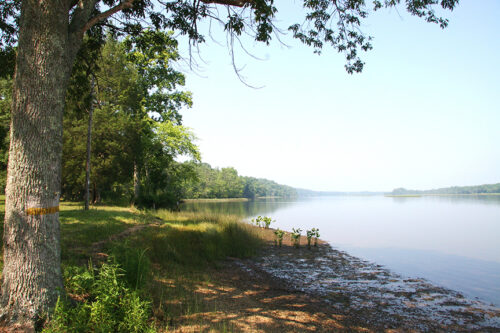VDOF manages 26 state forests totaling 74,286 acres. The state forests of Virginia are self-supporting and receive no taxpayer funds for operation. Operating funds are generated from the sale of forest products, the purchase of state forest use permits, and Virginia’s income tax check off system.
The formation of the state forest system created a way for the Commonwealth to manage working forestland for a steady supply of timber. In addition, the state forests ensure operation and maintenance of this natural resource, help maintain a stable local economy, provide recreational opportunities for the public, maintain wildlife habitats, create natural reserves, and preserve water quality. State forests provide education and demonstration of forest management techniques. The Virginia state forest system follows these forest management guidelines:

Up to 25% of the revenues received from the sale of forest products are returned to the counties in which the forests are located. You can support educational programs on your state forests by donating a portion of your state income tax refund to Virginia’s State Forests Fund.
All of Virginia’s state forests, covering more than 71,000 acres, are certified to the Sustainable Forestry Initiative (SFI) and American Tree Farm System (ATFS) standards. Certification ensures that forestry is practiced in an environmentally responsible and socially beneficial manner. Certification also demonstrates for landowners how they can maintain their own viable, sustainable working forests.
Agency staff conduct a long-term resource analysis which guides forest management planning within each state forest. The agency develops State Forest Management Plans for each state forest taking into account an appropriate level of activities to meet the objectives, size and scale of each state forest, deed restrictions, and overall land management operations.
The state forests are self-supporting and sell forest products to generate operating income as well as manage the forest resource responsibly. This is typically via timber sales and firewood sales. Cutting of timber on state forests requires having purchased an advertised timber sale or with a Firewood Permit. Firewood permits are issued by VDOF; firewood is generally sold by estimated cord, with VDOF forester-designated tree or trees, or fallen trees on the ground in a given area. Contact the state forest headquarters about timber sales or firewood permits.
Most Virginia state forests are accessible to the public. Virginia’s state forests offer abundant passive recreational activities, such as hiking, biking, horseback riding, hunting, and fishing. Permissible uses vary among individual forests, so visit the web page for each state forest to find out what is allowed and available.
While you won’t find amenities like cabins, campgrounds, or even restrooms at most state forests, you will find unique opportunities to enjoy the outdoors and observe wildlife and forestry practices in action. A State Forest Use Permit is required for hunting, trapping, fishing, mountain biking, and horseback riding; other appropriate licenses may be additionally required for certain activities (i.e., hunting, trapping, fishing).
Visitors asked to adopt a “leave-no-trace” ethic when visiting the forest, as there are generally no restrooms or trash cans on the forests themselves.
Read more about recreation and hunting on state forests.
To ensure your safety and enjoyment, please read Before You Visit when planning your trip to a state forest.
Download or print the state forest map and directions for the forest you wish to visit – many state forests are remote with limited cell phone service. These maps will work with Avenza Maps™, a mobile map app that allows you to track your movements offline on your iOS and Android device without the need for cell service or internet connection. A free version of this app can be downloaded to your device through your app store.
Ever wonder just what the difference is between state forests, state parks, wildlife management areas, natural area preserves, national forests, and national parks? Learn just what the difference is.
For more information or questions, e-mail us with “state forest name” in the subject line for specific state forest inquiries.